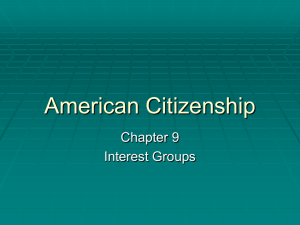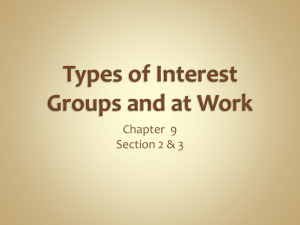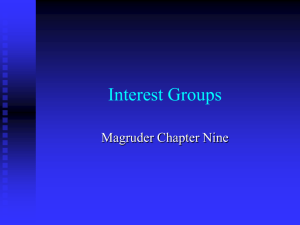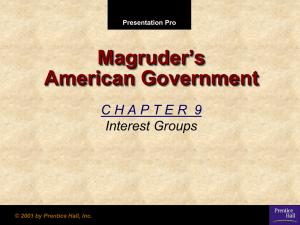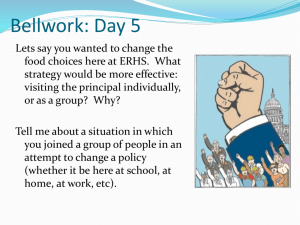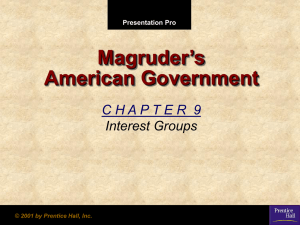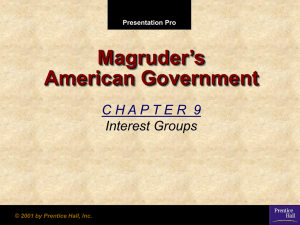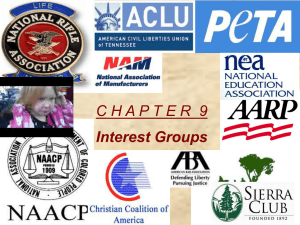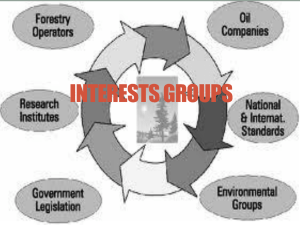Chapter 5 Political Parties
advertisement
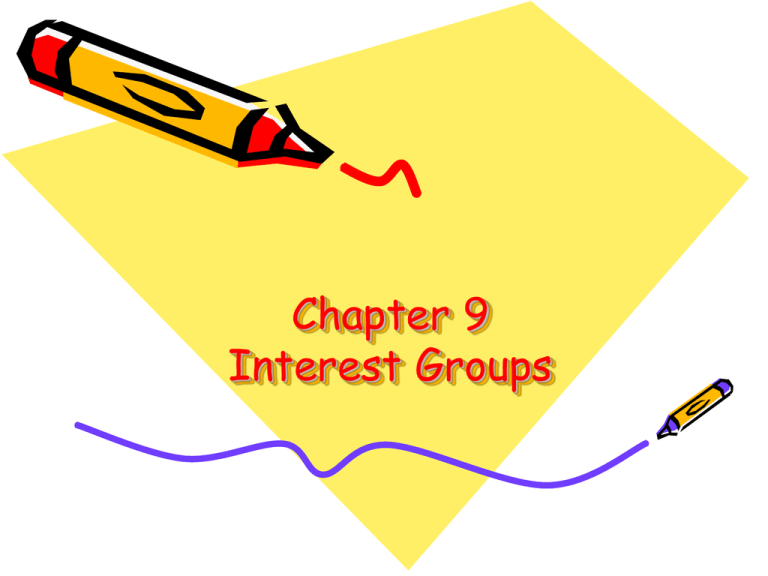
Chapter 9 Interest Groups Section 1—The Nature of Interest Groups • Objectives: – Describe the role of interest groups in influencing public policy. – Compare and contrast political parties and interest groups. – Explain why people see interest groups as both good and bad for American politics. Section 1—The Nature of Interest Groups • Why It Matters: – Aware of it or not, you almost certainly belong to at least one interest group today. And, knowingly or not, you will join several more of these groups over coming years. Section 1—The Nature of Interest Groups • Political Dictionary: – Public Policy – Public Affairs Section 1—The Nature of Interest Groups • The Role of Interest Groups – Pressure groups, special interest, organized interest. . .etc. – Leagues, clubs, federations, unions, committees, associations, etc. – Lord Byron: “Where the body is, there will the vultures be gathered.” Section 1—The Nature of Interest Groups • Political Parties and Interest Groups – Parties nominate candidates, interest groups do not – Parties are interested in winning elections, interest groups in issues or policy. – Parties have wide interests, interest groups narrow Section 1—The Nature of Interest Groups • Interest Groups: Good or Bad? – Two Early Views • James Madison warned against “factions” • Alexis de Tocqueville—saw them as good Section 1—The Nature of Interest Groups – Valuable Functions of Interest Groups • Stimulate interest in public affairs • Represent shared interests and not geography • Provide useful information • Vehicles for political participation • Provide checks and balances • Competing interests limit excesses in government policy Section 1—The Nature of Interest Groups – Criticisms • • • • Influence beyond their size Disguise for who they really represent Often dominated by a vocal minority Shady tactics—bribery, threats, etc. Section 2—Types of Interest Groups • Objectives: – Explain how the American tradition of joining organizations has resulted in a wide range of interest groups. – Describe four categories of groups based on economic interests. – Outline the reasons why other interest groups have been created. – Identify the purpose of public-interest groups. Section 2—Types of Interest Groups • Why It Matters: – America is “a nation of joiners”— including joiners of interest groups. Some of these groups are based on economic interests, some on other issues. Some are public-interest groups, which seek to benefit Americans. Section 2—Types of Interest Groups • Political Dictionary: – Trade Association – Labor Union – Public-Interest Group Section 2—Types of Interest Groups • An American Tradition – – – – – – – Old-new Big-small Structured-open Wealthy-poor Cause or idea Most are economic We belong to “many” groups Section 2—Types of Interest Groups • Groups Based on Economic Interests – Business Groups • • • • NAM Chamber of Commerce Business Roundtable Trade Associations Section 2—Types of Interest Groups • Groups Based on Economic Interests (cont). – Labor Unions • • • • AFL-CIO Truckers Police, Firemen, etc. Public Unions Section 2—Types of Interest Groups • Groups Based on Economic Interests (cont.) – Agricultural Groups • National Grange • American Farm Bureau • National Farmers Union – Professional Groups • • • • American Medical Association National Education Association American Bar Association Many others. . . Section 2—Types of Interest Groups • Other Interest Groups – Groups That Promote Causes • • • • American Civil Liberties Union (ACLU) National Women’s Caucus Audubon Society Many others . . . Section 2—Types of Interest Groups • Other Interest Groups (cont.) – Organizations That Promote the Welfare of Certain Groups • • • • American Legion/VFW AARP NAACP Many others . . . Section 2—Types of Interest Groups • Other Interest Groups (cont.) – Religious Organizations • National Council of Churches • American Jewish Congress • Many others . . . • Public-Interest Groups – League of Women Voters, Common Cause, Ralph Nader’s Group – Many others . . . Section 3—Interest Groups at Work • Objectives: – Explain interest groups’ three major goals in influencing public opinion. – Describe how interest groups use propaganda to persuade people to their point of view. – Analyze how interest groups try to influence political parties and elections. – Examine how lobbying brings group pressures to bear on the process of making public policy. Section 3—Interest Groups at Work • Why It Matters: – Flip through a newspaper or surf television or the Internet and you will no doubt see examples of interest groups at work—that is, using propaganda aimed at influencing public attitudes. Interest groups also work through political action committees and lobbyists to influence political parties and public policy. Section 3—Interest Groups at Work • Political Dictionary: – – – – Propaganda Single-interest group Lobbying Grass roots Section 3—Interest Groups at Work • Influencing Public Opinion – To supply needed information about a topic or cause – To build a positive image for the group – To promote a particular policy Section 3—Interest Groups at Work • Propaganda – Its goal is to create a particular belief— it may be true or false – Begins with a conclusion—not objective – Glittering generalities – Testimonials Section 3—Interest Groups at Work • Influencing Parties and Elections – Candidate support or denial of support – PACS—single-interest groups • Lobbying – 20,000 in Washington – From ALL sectors of society Section 3—Interest Groups at Work • Lobbying (cont.) – Lobbyists at Work • • • • • • • Legislative counsel Many former representatives Provide information Stimulate grass-roots pressure Rate the representatives Campaign contributions Never give up . . . Section 3—Interest Groups at Work • Lobbying (cont.) – Lobby Regulation • Lobbying Disclosure Act of 1995 – Registration – “Principal Purpose” Section 3—Interest Groups at Work Section 3—Interest Groups at Work Section 3—Interest Groups at Work
